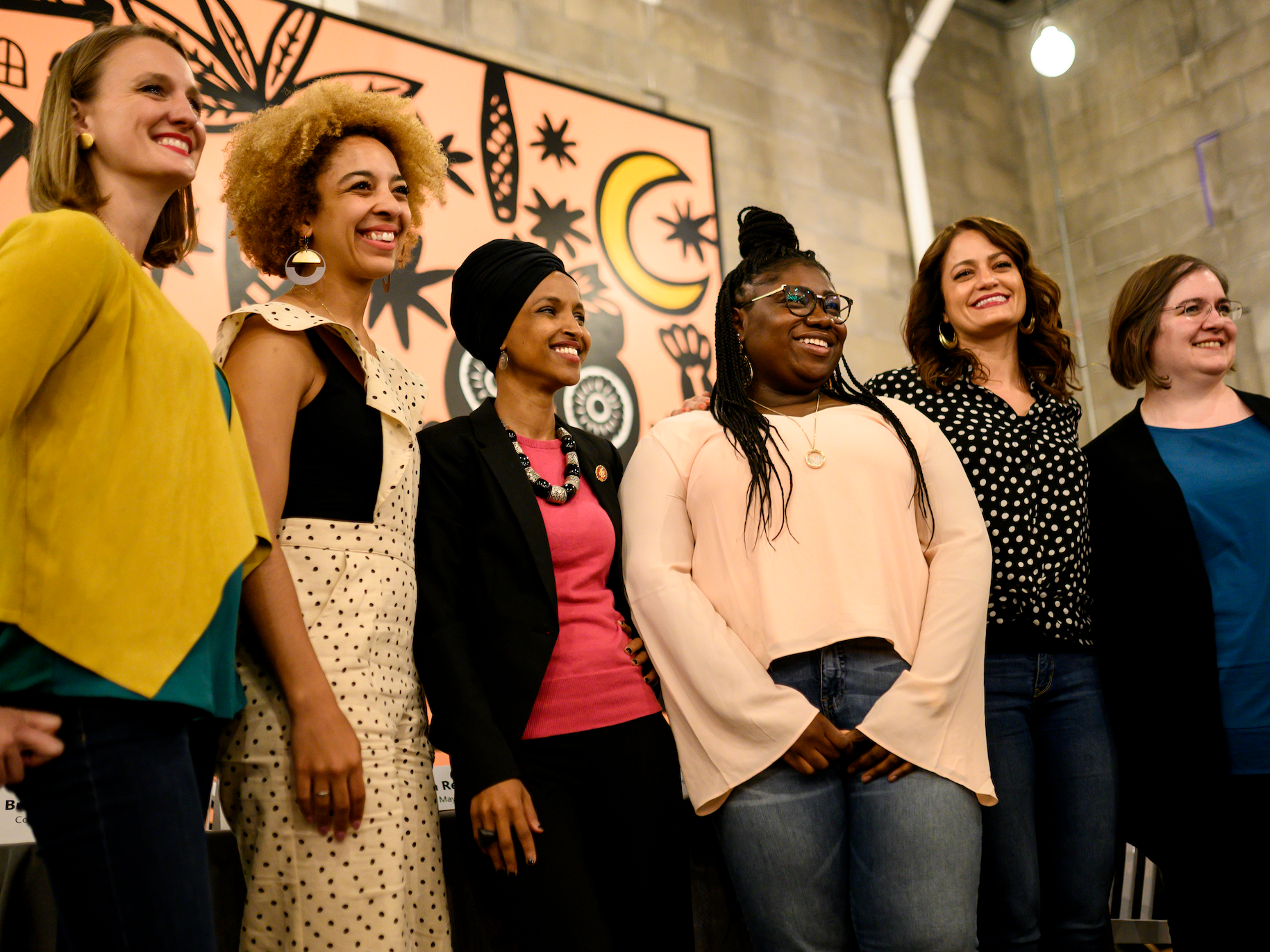- This year’s Women’s Equality Day is on August 26, to commemorate the 1920 adoption of the 19th Amendment ensuring women the right to vote throughout the United States, though women of color wouldn’t fully secure that right until decades later.
- Even though a lot of progress has been made, the gender wage gap persists.
- The median full-time, year-round female worker made just 81.6 cents for every dollar her male counterpart made in 2018.
- That gap in pay varies widely based on location, race, and several other factors.
- Visit Business Insider’s homepage for more stories.
Women’s Equality Day, August 26, is a day that celebrates the passage of the 19th Amendment, which gave (some) women the right to vote. Black women and women of color wouldn’t get that right until the Civil Rights Act of 1964.
And while women have gained important political power, there is still much work to be done to reach equality, especially when it comes to financial power.
One of the most glaring issues is the gender wage gap, the difference in earnings between men and women. The gap is especially prevalent during the economic struggles caused by the novel coronavirus pandemic.
According to the National Women’s Law Center as reported by Fortune, working women are especially affected by the coronavirus as they make up a large percentage of the labor force in industries that are seeing large numbers of layoffs. “Women hold 70% of restaurant server positions, generally earning 79% of what men do,” Fortune wrote.
Over half a century after the US passed the Equal Pay Act, American women still face a substantial gender wage gap across the spectrum.
In 2018, a woman working full time earned 81.6 cents for every dollar a man working full time earned on average. Additionally, women's median annual earnings were $9,766 less than men's, according to the most recent available data from the US Census Bureau.
The Fortune article also noted that many women on the front lines of the coronavirus outbreak, such as nurses helping treat patients with the coronavirus or store workers keeping groceries and goods stocked, make less than men in the same occupation on average.
While progress has been made toward pay parity between the sexes, the Institute for Women's Policy Research estimates that it will not be reached until 2059.
The seven charts below illustrate the significant pay discrepancies between men and women based on race, age, geographical location, and more.
The gender wage gap varies widely depending on the state
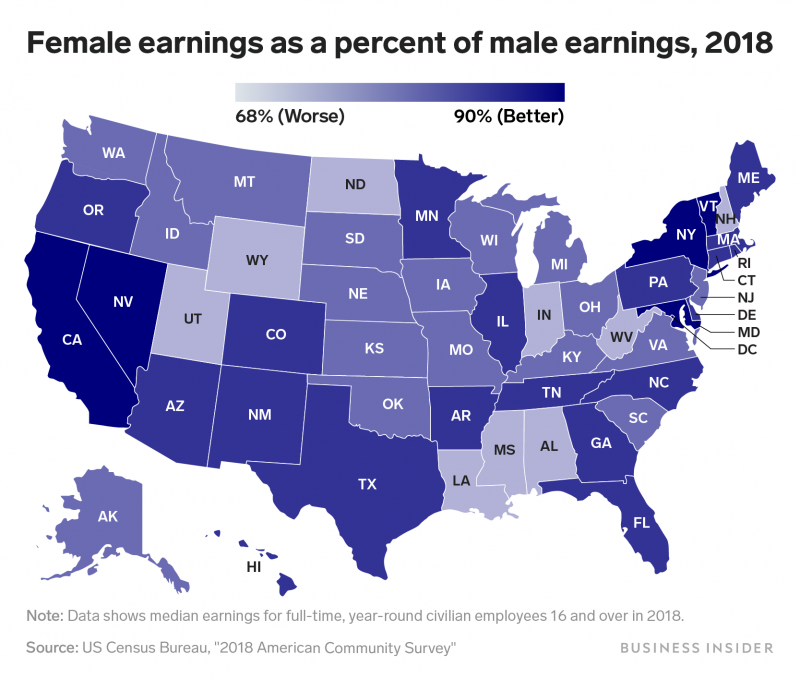
According to data from the US Census Bureau, the average gender pay gap in the United States in 2018 was around 18.9%, meaning that a woman working a full-time, year-round job earns 81.1% as much as her male counterpart earns.
The pay gap varies, however, by state.
In Wyoming, for instance, the gender pay gap is 30.9%, the biggest wage gap in the nation. Louisiana is followed closely behind at 30.8%. In 30 states, the gender pay gap is larger than the national average.
Most states have implemented laws against gender discrimination, and the 1964 Civil Rights Act protects women at the federal level, yet disparities persist.
California had the smallest pay gap in 2018 at 12.2%, with full-time, year-round women over 16 making a median salary of $49,177, while men made $56,023.
Major cities show an even bigger discrepancy

Around the US, salaries in large cities show an even greater range of pay discrepancy between men and women.
A 2019 report from the American Association of University Women, a nonprofit that advocates for gender equality, examined how much women earn compare to men in 25 major metro areas using 2018 US Census data from the American Community Survey and Current Population Survey.
Out of the 25 cities, the narrowest gender wage gap overall is in Los Angeles, where women make approximately 91% of the median salary for men. Seattle had the widest wage gap: Women earn around 78% of what men make in the city.
Read more about the pay gap in 25 US cities here.
Overall, black and Hispanic women face the biggest pay gap when compared to white men

Black and Hispanic women are most affected by the wage gap, especially when compared to white men, who make up the largest demographic segment of the workforce.
We looked at the wage gap for different racial and ethnic groups using median earnings data for full-time, year-round workers from the US Census Bureau's 2018 1-year American Community Survey.
Asian women face the smallest wage gap - they earn 97% of what white men earn, resulting in a pay gap of just 3%. White women earn 80% of what white men do, while black women earn 66% and Hispanic women earn 58%, a pay gap of 42%.
When compared to black men, black women earn 89.4%, and Hispanic women make 84.8% of what Hispanic men do.
The larger disparity between white men's and women of color's earnings could be attributed to the fact that "women of color suffer both because of their gender and their race," according to an April 2016 report released by the Senate Joint Economic Committee's Democratic Staff.
Another way of looking at that gap for women of different racial and ethnic groups is to consider when "equal pay day" for each group falls.
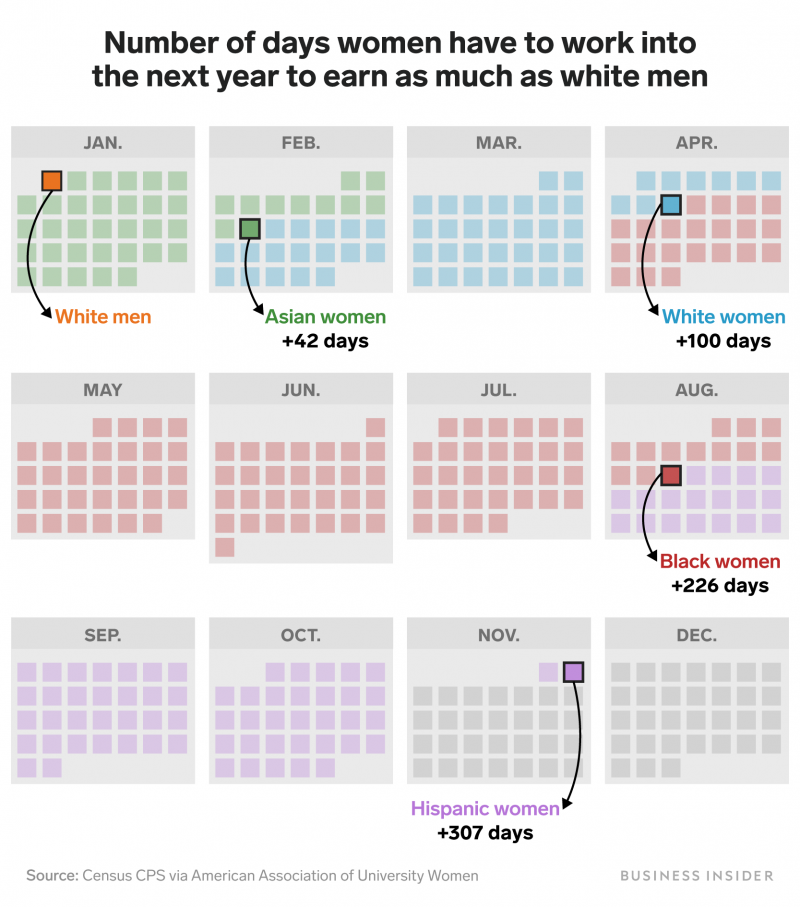
The above calendar graphic shows how many days into the next year a woman has to work in order to earn what a white man would have earned in the previous year using estimates from the American Association of University Women.
Equal pay day for all women falls this year on March 31. Equal pay day falls much later in the year for some racial and ethnic groups.
For example, a typical full-time, year-round employed black female worker starting on January 1, 2019, would have finally earned on August 13, 2020, what a similarly employed white male worker would have made over the course of 2019 alone.
It takes full-time, year-round employed Asian women the shortest time to make what a white man would have made the year before. It would take an Asian female worker 42 days into 2020, or until February 11, to earn what a white man earned the year before.
Read more about equal pay day by race here.
Women with children gain no salary boost, while men with children are rewarded
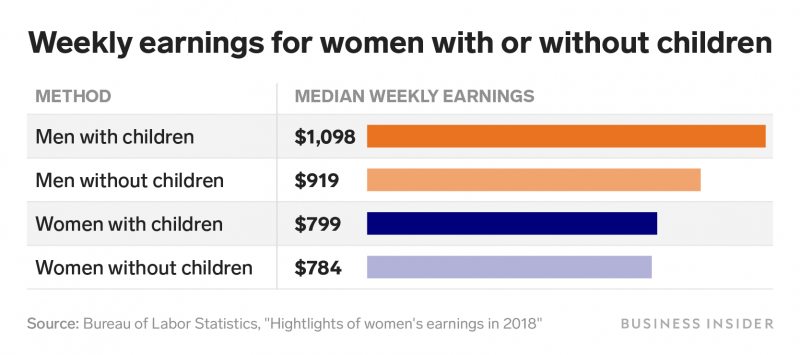
In 2015, women with children were earning roughly the same as women without children, $727 and $726 respectively. However, working fathers with children earned about $141 more than a men without children.
That gap has slowly been closing since then, as 2018 data from the Bureau of Labor Statistics show that women with children now make slightly more than women without kids under 18 at home.
Men with children see an earnings boost, and the difference between their weekly take-home pay was on average $179 higher than their counterparts without kids in 2018.
For working women, the difference in earnings between women with and without children is minimal. Working mothers only made $15 compared to other working women in 2018.
While this disparity can be attributed to differences in careers and work hours between men and women who have children and those who do not, a 2016 report released by the Senate Joint Economic Committee Democratic Staff says that there is also a difference in how working mothers and fathers are perceived by management.
According to the report, some employers may view motherhood as a "signal of lower levels of commitment and professional competence." Working fathers, on the other hand, may be viewed as having "increased work commitment and stability."
Women's earnings are lower than men's over the course of a lifetime
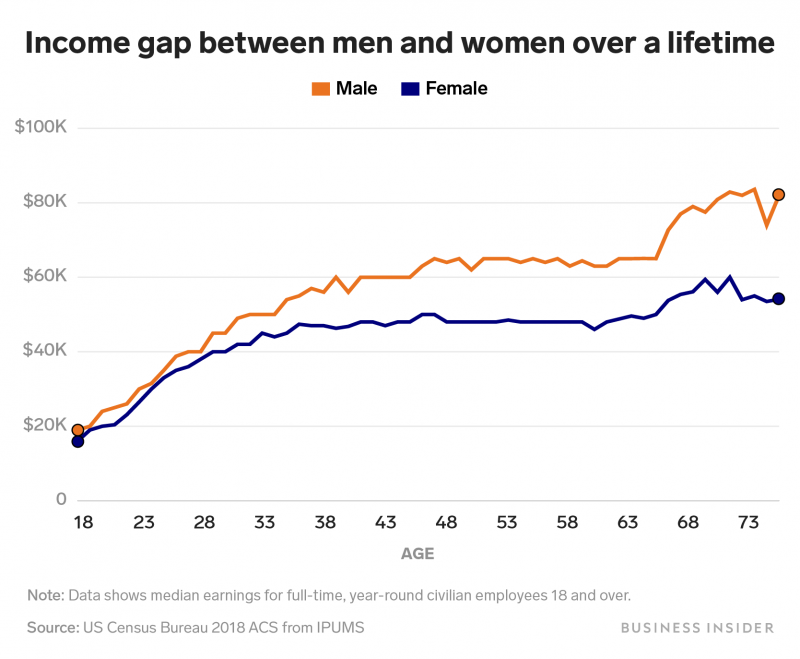
The gender pay gap exists for workers across a lifetime.
Using Census data from the Minnesota Population Center's IPUMS program, we found that the median full-time, year-round male worker earns more than his female counterpart at every year of age.
The gap is narrower for younger workers, with the median 25-year-old woman earning about 94.3% of the median 25-year-old man. Meanwhile, the median 50-year-old woman earns just 77.4% of her 50-year-old male counterpart.
Women over the age of 75 are almost twice as likely to live in poverty, according to the Senate report.
Many women that age didn't work when they were younger, so they have fewer sources of retirement income than men their age.
In 1950, about 34% of American women were in the labor force, compared to 86% of men, according to the Bureau of Labor Statistics.
By 1980, the numbers were 52% and 77% respectively - and the numbers have largely plateaued since then. In 2018, about 57% of women are part of the workforce, compared to 69% of men, according to data from the US Bureau of Labor Statistics.
Read more about earnings over a lifetime by gender here.
The number of women promoted to the highest levels within companies reveals unconscious biases

Very few women are CEOs of major corporations, or in the C-level suite of executives running corporate America.
Data from a study put together by McKinsey & Co. and Lean In show how men are promoted up, while women fall by the wayside.
They surveyed 329 companies employing more than 13 million people, and found only one in five C-level executives were women.
Women of color are furthermore underrepresented at the executive level, making up only 1 in 25 C-level executives.
Since 2015, there's been an increase in the share of women in the C-Suite, while women in lower-level management roles have seen a smaller increase since that year.
The latest McKinsey report suggested that more women are working in senior positions, but it is still hard for women to move up from entry-level jobs into higher roles. "For every 100 men promoted and hired to manager, only 72 women are promoted and hired," the report said, which affects the number of women being promoted to higher positions in the corporate pipeline.
However, women consistently ask for promotions and raises more. One of the reasons for the disparity between women asking for promotions and actually getting them was because when women negotiate, people like them less for it, according to a previous McKinsey study covered by Business Insider found.
According to Lean In, women who negotiate are more likely than men who negotiate to receive feedback that they are "intimidating," "too aggressive," or "bossy."
Another recent poll by American Express and The New York Women's Foundation found that less than one-third of women were comfortable with calling themselves ambitious. According to psychologists interviewed by Business Insider, the reasoning behind this is that the word could be seen as aggressive.
Harvard Business Review found in their research that women ask for raises just as much as men but men are more "successful" with their requests, with a success rate of 15% for women and 20% for men.
Read more about the share of women in corporate positions here.
